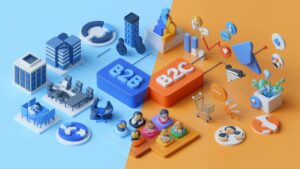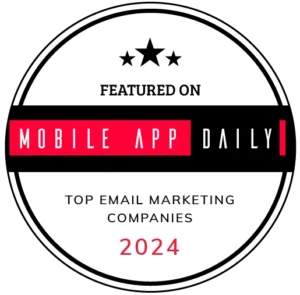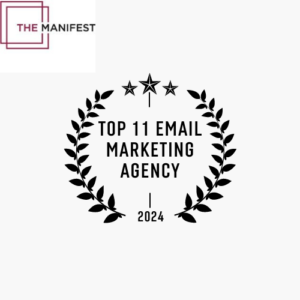Lead generation is one of the most important concepts in the world of marketing and sales. It refers to the process of identifying, attracting, and nurturing potential customers, known as leads, who may eventually convert into loyal clients. As businesses continue to shift towards digital platforms, lead generation has become a critical element of growth strategies in 2025.
But why is lead generation so important? In today’s market, having a great product or service alone isn’t enough. You need to attract the right people—those who are actively looking for what you offer or who could benefit from it. Lead generation plays a crucial role in bridging the gap between attracting website visitors and converting them into long-term customers.
In this guide, we’ll explore the key concepts of lead generation, how it differs in B2B (Business-to-Business) and B2C (Business-to-Consumer) markets, and the strategies and tools you can use to grow your business. Whether you are a beginner or experienced marketer, understanding these concepts will help you stay ahead of the curve in 2025.
What is a Lead?
Before we dive into the process of lead generation, it’s important to first understand what a “lead” is. In simple terms, a lead is a person or organization that has shown interest in your product or service in some way. This interest can come from a variety of actions, such as signing up for your newsletter, filling out a contact form, or downloading a free resource from your website.
Leads are not customers yet, but they represent potential future buyers. Think of them as people who are on the fence, considering whether or not to make a purchase. The goal of lead generation is to engage with these leads, nurture their interest, and eventually turn them into paying customers.
What is Lead Generation?
Lead generation is the process of identifying, attracting, and converting strangers into leads—people who may eventually become your customers. The purpose of lead generation is simple: to create a steady stream of potential customers who can be nurtured through your marketing and sales process.
Lead generation involves various strategies such as content marketing, paid advertising, email campaigns, and social media engagement. The ultimate goal is to attract the right audience to your business and then use targeted efforts to move them through the sales funnel, from awareness to consideration, and finally to the decision-making stage.
Types of Leads
Not all leads are the same, and understanding the different types is essential for effective lead generation. Here are the most common types of leads:
-
Marketing Qualified Leads (MQLs):
These are leads who have shown interest in your business through activities like downloading an eBook, subscribing to a blog, or attending a webinar. They are more engaged than general visitors but aren’t yet ready to make a purchase. MQLs are typically nurtured through additional content and communications to help them move toward the decision stage.
-
Sales Qualified Leads (SQLs):
SQLs are leads who have taken actions that indicate they are ready to make a purchase. They might have requested a demo, reached out directly to your sales team, or shown interest in pricing. SQLs are often passed from the marketing team to the sales team for direct follow-up and conversion efforts.
-
Cold Leads:
Cold leads are individuals or businesses who have shown little or no interest in your products or services. These leads require extra effort to warm them up and engage with them. Cold leads may come from purchased lists or individuals who have interacted with your brand in the past but haven’t shown much intent.
-
Warm Leads:
Warm leads are those who have expressed some level of interest in your business but aren’t yet ready to make a purchase. They might follow you on social media, open your emails, or browse your website. These leads need nurturing through relevant content and personalized communication to convert them into sales-qualified leads.
B2B vs. B2C Lead Generation

B2B (Business-to-Business) refers to transactions between two businesses, where one company sells products or services to another. In contrast, B2C (Business-to-Consumer) focuses on selling directly to individual consumers. While both models aim to generate leads and drive sales, the strategies and approaches differ significantly based on the audience, sales cycle, and marketing tactics.
Key Differences
-
Target Audience
- B2B: Targets businesses, specifically decision-makers like CEOs, managers, and department heads.
- B2C: Targets individual consumers, focusing on their personal needs and desires.
-
Sales Cycle
- B2B: Longer, more complex process that involves multiple decision-makers, research, and negotiations.
To learn in-depth about the B2B sales cycle check this blog – The Complete Guide to the B2B Sales Cycle - B2C: Shorter and more transactional, with consumers often making quicker, emotional purchasing decisions.
- B2B: Longer, more complex process that involves multiple decision-makers, research, and negotiations.
-
Lead Nurturing
- B2B: Nurturing is focused on building long-term relationships through educational content, case studies, and personalized communication.
- B2C: Involves emotionally-driven content, special offers, and promotions to engage and convert consumers quickly.
The Lead Generation Process
The lead generation process involves several stages, from identifying potential leads to converting them into loyal customers. Understanding each step in the process helps businesses effectively manage leads and optimize their strategies for maximum results.
-
The Lifecycle of a Lead
-
Awareness:
At the start of the lifecycle, potential leads become aware of your brand, products, or services. This stage often occurs through content marketing, social media, ads, or word-of-mouth. Leads are still in the discovery phase and may not yet have a clear need for your product.
-
Interest:
As leads begin to understand how your offering addresses their pain points, they move to the interest stage. Here, they may engage with your content, such as reading blogs, signing up for newsletters, or following your brand on social media.
-
Consideration:
In this stage, leads are actively evaluating solutions. They may download case studies, request demos, or attend webinars. They are considering whether your product or service is the right fit for their needs.
-
Decision:
Leads in the decision stage are ready to make a purchase or sign a contract. They have weighed their options and are looking for final reassurance, such as pricing, testimonials, or product guarantees.
-
Post-Purchase:
Once a lead has converted, they enter the post-purchase stage. This phase focuses on customer retention, upselling, and ensuring customer satisfaction to turn them into repeat buyers or advocates.
-
Lead Capture
Lead capture is the process of attracting and collecting contact information from potential leads. The goal is to move leads from being just visitors or prospects into your database for future nurturing. Common methods of lead capture include:
-
Lead Magnets:
Offering free resources, like eBooks, white papers, or downloadable guides, in exchange for contact details (like email addresses). These magnets provide value and entice potential leads to share their information.
-
Forms and Landing Pages:
Using forms on your website or dedicated landing pages to collect data. These forms might ask for basic information like name, email, and company details.
-
Social Media and Ads:
Using targeted ads on platforms like Facebook or LinkedIn to encourage leads to sign up for newsletters, offers, or free trials.
-
Webinars and Events:
Hosting online webinars or events to engage potential leads and capture their information for follow-up.
-
Lead Qualification
Once you’ve captured leads, it’s essential to qualify them to ensure they are worth pursuing. Lead qualification helps you focus your efforts on the most promising prospects. There are two main methods:
-
BANT (Budget, Authority, Need, Timeline):
BANT is a traditional method of lead qualification, asking whether the lead has the budget for your product, the authority to make a purchasing decision, a clear need for the product, and a defined timeline for purchase.
-
CHAMP (Challenges, Authority, Money, Prioritization):
CHAMP focuses on understanding the challenges the lead is facing, who has the authority to make the decision, their budget, and how high a priority your solution is for them. This method helps to identify if your product can solve a real problem for the lead.
-
Lead Scoring:
Lead scoring assigns points to leads based on specific criteria such as engagement level, company size, or readiness to buy. Higher scores indicate a better-fit lead, while lower scores suggest they may require more nurturing.
-
Lead Nurturing
Lead nurturing is the ongoing process of building relationships with leads and guiding them toward making a purchase decision. Effective lead nurturing ensures that potential customers remain engaged with your brand until they are ready to buy. Key nurturing strategies include:
-
Email Marketing:
Sending personalized and targeted emails that provide value, educate, and keep the lead engaged with your brand. This might include product updates, case studies, or special offers.
-
Content Marketing:
Offering valuable content (blogs, eBooks, videos) that helps leads solve their problems or make informed decisions. Content that speaks directly to a lead’s pain points will strengthen your relationship.
-
Retargeting Ads:
Using retargeting ads to bring leads back to your website based on their previous interactions. These ads keep your brand top of mind and encourage them to complete an action, like signing up or purchasing.
-
Personalized Outreach:
Reaching out to leads personally through calls, LinkedIn messages, or one-on-one consultations. Personalized communication helps build trust and fosters a stronger relationship.
Lead Generation Trends in 2025
As we move into 2025, lead generation is being reshaped by shifts in consumer behavior and advances in technology. To stay competitive, businesses need to understand these trends and adapt quickly.
Shifts in Consumer Behavior
Consumers are now more informed and selective than ever. They expect personalized, relevant experiences at every stage of the buying journey. As they interact across multiple platforms, transparency and trust are crucial. Brands that provide value and engage authentically with leads are more likely to build lasting relationships and convert prospects into customers.
The Role of Technology in Lead Generation
Technology is playing a central role in streamlining lead generation. AI and machine learning are enhancing lead qualification by analyzing data to predict conversions more accurately. LinkedIn automation tools allow for more targeted outreach, ensuring businesses connect with the right decision-makers. Chatbots are also improving real-time communication, offering personalized recommendations and engaging potential leads instantly.
Integration of CRM and marketing automation tools is also simplifying the nurturing process, enabling businesses to track leads, deliver tailored content, and optimize their efforts for better results.
Business Benefits
Adopting these trends brings significant business benefits:
- Efficiency: Automation reduces manual tasks, freeing up time for higher-value activities.
- Higher Conversions: Personalized, targeted outreach improves conversion rates.
- Cost Savings: Automation tools cut down on lead generation costs.
- Better Insights: Data-driven decisions become easier with enhanced tracking and analytics.
Lead Generation Strategies for B2B and B2C
Lead generation strategies differ between B2B (Business-to-Business) and B2C (Business-to-Consumer) models. However, some approaches work well universally. Let’s explore the most effective strategies for each.
For B2B Lead Generation
-
LinkedIn Outreach:
LinkedIn is a powerful platform for B2B lead generation. Personalized connection requests and direct messages help businesses connect with decision-makers and industry professionals.
-
Content Marketing:
B2B companies benefit from sharing in-depth, educational content like whitepapers, case studies, and industry reports. This builds credibility and nurtures leads over time.
-
Email Campaigns:
Targeted email campaigns that provide valuable insights, product demos, or updates can engage leads. Automation tools can help scale and personalize outreach for better results.
-
Webinars & Events:
Hosting webinars or attending industry events allows businesses to engage directly with prospects, offering expertise while generating new leads.
For B2C Lead Generation
-
Social Media Advertising:
Platforms like Facebook, Instagram, and TikTok are excellent for reaching B2C audiences. Running targeted ads based on interests, behaviors, and demographics is key to attracting potential customers.
-
Influencer Marketing:
Partnering with influencers who resonate with your target market can quickly raise brand awareness and drive leads, especially in visually-driven industries.
-
Discounts & Promotions:
Offering time-sensitive discounts or exclusive deals can compel consumers to take immediate action, driving conversions.
-
Referral Programs:
Encouraging existing customers to refer friends and family can increase word-of-mouth leads and boost brand trust.
Universal Strategies
-
SEO Optimization:
Both B2B and B2C businesses should invest in SEO to increase organic traffic. Keyword research, on-page optimization, and high-quality content can attract leads from search engines.
-
Lead Magnets:
Offering valuable resources like eBooks, guides, or free trials in exchange for contact information helps capture leads from both markets.
-
Retargeting Ads:
Using retargeting ads to re-engage visitors who showed interest but didn’t convert can significantly increase lead generation efforts for both B2B and B2C companies.
-
Personalized Content:
Whether in B2B or B2C, personalized content that speaks to the lead’s pain points or interests builds stronger connections and drives higher conversions.
Measuring Lead Generation Success
Measuring the success of your lead generation efforts helps you optimize strategies for better results. Key metrics and funnel analysis are essential to track progress and refine your approach.
Key Metrics to Track for B2B vs. B2C
-
For B2B Lead Generation:
- Conversion Rate: Percentage of leads that become paying customers.
- Lead Quality: Track the potential of leads to convert into high-value clients.
- Cost Per Lead (CPL): How much it costs to acquire each lead.
- MQLs vs. SQLs: Track the transition from Marketing Qualified Leads (MQLs) to Sales Qualified Leads (SQLs).
-
For B2C Lead Generation:
- Conversion Rate: The percentage of leads that make a purchase.
- Customer Lifetime Value (CLV): Measures how much each customer brings in over time.
- Cost Per Acquisition (CPA): The cost of acquiring one customer.
- Engagement Rate: Metrics like likes, shares, and comments on social media.
Analyzing the Lead Funnel
-
Top of the Funnel (TOFU):
Track awareness metrics like website traffic and social media engagement. Low numbers may indicate a need to improve outreach.
-
Middle of the Funnel (MOFU):
Measure lead engagement through email opens, content downloads, and webinar sign-ups. A drop here suggests the need for more nurturing content.
-
Bottom of the Funnel (BOFU):
Conversion rate and sales pipeline progression are key. If these are low, optimize your sales process to address any concerns preventing purchases.
-
Post-Purchase Stage:
Track customer satisfaction, retention, and referral rates. Loyal customers help generate new leads through word-of-mouth.
Tips to Master Lead Generation
Mastering lead generation requires understanding your audience, leveraging technology, and staying on top of trends. Here are some key tips:
1. Understand Your Audience (B2B vs. B2C Differences)
- B2B: Focus on building relationships and offering valuable, industry-specific content.
- B2C: Appeal to individual needs with emotional connections, targeted ads, and personalized offers.
Tailor your approach based on these differences to enhance results.
2. Leverage Technology to Personalize
Use CRM systems and AI tools to segment leads and personalize outreach. Automated, tailored emails and offers can increase engagement and conversions.
3. Experiment with Trends Like AI and Voice Search
- AI: Use AI chatbots for instant engagement and personalized recommendations.
- Voice Search: Optimize content for voice search with natural language keywords to stay ahead in rankings.
By understanding your audience, personalizing experiences, and adopting new trends, you can master lead generation and drive high-quality leads.
Conclusion
Effective lead generation is the foundation of business growth, whether you’re in B2B or B2C. By understanding your audience, leveraging technology for personalization, and staying ahead of trends like AI and voice search, you can create a lead generation strategy that delivers results. Remember, success comes from consistently optimizing your approach, measuring key metrics, and adapting to changes in the market. Master these strategies, and you’ll be on your way to generating high-quality leads and driving business success.
If you’re looking for experts who understand this industry and its challenges, reach out to us for a quick intro call and get to know more about how SalesHarbor can assist you. We specialize in B2B lead generation, offering services such as appointment setting and sales consulting to help businesses grow their revenue by generating high-converting sales-qualified leads.



